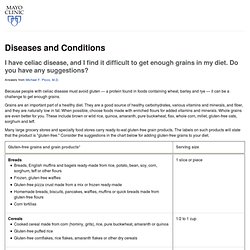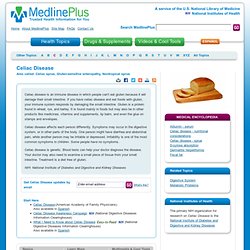

Grains and Flours Glossary. Diet & Lifestyle. Newly Diagnosed with Celiac Disease?

If you are new to the gluten-free diet it can be an overwhelming prospect to know where to start. Please keep the following things in mind while beginning your new life living gluten-free! Think positively - This is a welcome change for your body. Your system will thank you for it! Remember that the diet is the prescription, you can control it, and with a positive attitude and support from others it can be done! The CSA Gluten-Freee Product Listing Gluten-Free Diet Self-Management Basic Diet Choices Establish a Support Network Grains/Flours Glossary Guide to Oats Gluten-Free Labeling Maximizing Your Health. Gluten-Free Diet Self Management. Gluten Intolerance Group. Celiac Sprue Association. Celiac Disease. Celiac Disease What is celiac disease?

What are the symptoms of celiac disease? Why are celiac disease symptoms so varied? What other health problems do people with celiac disease have? How common is celiac disease? What is celiac disease? Celiac disease is a digestive disease that damages the small intestine and interferes with absorption of nutrients from food. The small intestine is shaded above. When people with celiac disease eat foods or use products containing gluten, their immune system responds by damaging or destroying villi—the tiny, fingerlike protrusions lining the small intestine. Villi on the lining of the small intestine help absorb nutrients. Celiac disease is both a disease of malabsorption—meaning nutrients are not absorbed properly—and an abnormal immune reaction to gluten.
Top What are the symptoms of celiac disease? Symptoms of celiac disease vary from person to person. Irritability is another common symptom in children. Why are celiac disease symptoms so varied? Celiac disease diet: How do I get enough grains? Because people with celiac disease must avoid gluten — a protein found in foods containing wheat, barley and rye — it can be a challenge to get enough grains.

Grains are an important part of a healthy diet. They are a good source of healthy carbohydrates, various vitamins and minerals, and fiber, and they are naturally low in fat. When possible, choose foods made with enriched flours for added vitamins and minerals. Whole grains are even better for you. These include brown or wild rice, quinoa, amaranth, pure buckwheat, flax, whole corn, millet, gluten-free oats, sorghum and teff. Many large grocery stores and specialty food stores carry ready-to-eat gluten-free grain products. *Products vary by manufacturer, so be sure that the brand you purchase is gluten-free. GlutenFreeDietGuideWeb.indd - Gluten-FreeDietGuideWeb.pdf. Celiac Disease. Celiac disease is an immune disease in which people can't eat gluten because it will damage their small intestine.

If you have celiac disease and eat foods with gluten, your immune system responds by damaging the small intestine. Gluten is a protein found in wheat, rye, and barley. It is found mainly in foods but may also be in other products like medicines, vitamins and supplements, lip balm, and even the glue on stamps and envelopes. Celiac disease affects each person differently. Symptoms may occur in the digestive system, or in other parts of the body.
Celiac disease is genetic. NIH: National Institute of Diabetes and Digestive and Kidney Diseases.